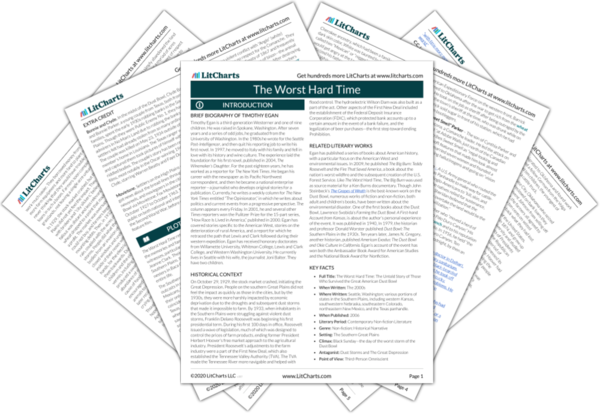The XIT ranch was the fulfillment of General Philip Sheridan’s vision of a land where the cowboy would dominate as an exemplar of an advanced civilization. However, the cowboy of Sheridan’s dreams would also be displaced and left to roam on the prairie, like the Comanche who initially held the ranch lands in the aftermath of the wheat boom, wondering what had happened to the land they once knew. The XIT ranch is thus a symbol of both socioeconomic change and the defeat of humanity in the face of nature. It is a land that, at various points in history, provided bison for Southwestern tribes, cattle-grazing lands for cowboys, and parcels of land to ambitious wheat farmers. No one was able to bend the land completely to their will, though each group that possessed it sought to determine the ranch land’s “natural” use. The ranch endured several phases of civilization, none of which endured.
XIT Ranch Quotes in The Worst Hard Time
Chapter 1 Quotes
The C-note was Uncle Dick’s heater, his blanket. As a child, Dick Coon’s family was often broke. The corrosive poverty hurt so much it defined the rest of his life. As long as Uncle Dick could touch his C-note, he had no fear in life. And he had certainly known fear. Dick Coon was fortunate to live through the Galveston hurricane of 1900, the worst single natural disaster in American history. He lost everything in Galveston but was never bitter. His life had been spared, while six thousand people lost theirs. Dick Coon didn’t plan on getting rich in Dalhart; didn’t even plan on staying in the High Plains. In 1902, he had been passing through Dalhart, making a train connection to Houston, when he fell under the spell of one of the syndicate’s real estate agents. He heard enough to buy his own piece of the old XIT […] but the real money was in town building.
Chapter 23 Quotes
A few days later, Uncle Dick was leaning against a rail in front of the DeSoto when he spotted a young cowboy and his family drifting through town. For five years now, Dick had watched a steady parade of jalopies and wagons float through Dalhart, the people staying only a night or two, and then moving on to some place where there might be work or stable land [….] The cowboy had wandered into town with the XIT reunion [….] Uncle Dick reached into his pocket and pulled out his hundred-dollar bill. He handed the money to the cowboy, told him to take it—it was his. The young man was stunned [….] Later, when the cowboy asked around about his benefactor, people told him it was Dick Coon, the richest man in town. He owned everything. But they were surprised to see him give up the C-note [….] Only Coon’s closest friends knew the truth: Uncle Dick was broke.












